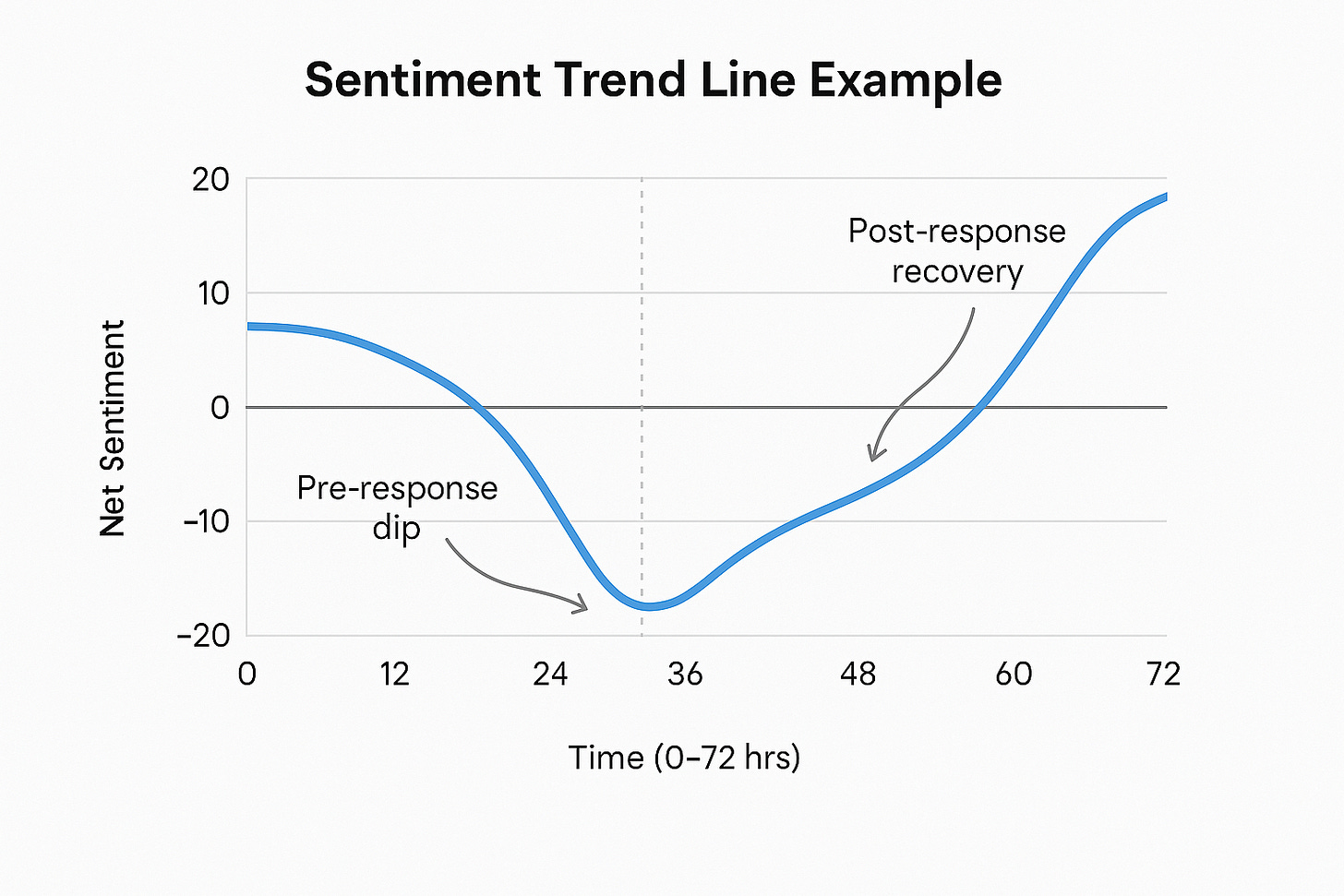Rapid Response Effectiveness Metric: Measuring What Matters in a Crisis
Quantifying the speed, strength, and impact of your campaign’s crisis response—before narratives harden.
I. Introduction
In today’s political environment, a single viral clip, soundbite, or headline can reshape the entire trajectory of a campaign. When something breaks, you don’t have days to respond—you have hours. And whether that response lands effectively or falls flat often determines the media narrative for days or weeks to come.
So how do you know if your campaign's response was fast enough? Or strong enough? Was it too late? Did it move sentiment in your favor?
That’s where the Rapid Response Effectiveness Metric (RREM) comes in: a way to quantify your crisis management in real time.
II. What Is the Rapid Response Effectiveness Metric?
The RREM is a composite score that tracks how well a campaign responds to an emerging issue or attack.
It consists of four core components:
Detection Time: How quickly did the campaign detect the issue?
Response Time: How soon was a public-facing message deployed?
Sentiment Shift: What change in public sentiment occurred after the response?
Narrative Reclaim: Did the campaign regain control of the conversation?
Fast responses are necessary—but impact is essential. A weak or tone-deaf message, even if fast, won’t stabilize a story. RREM is about measuring both speed and outcome.
III. Why Timing Is Everything
In the era of algorithmic newsfeeds, media narratives calcify quickly.
As Panagopoulos (2021) notes, campaigns that respond more than 24 hours after an attack often fail to move public perception back in their favor. Meanwhile, research into online misinformation and crisis communication finds that negative messages travel faster and wider than corrective ones.
Delays are deadly. Most campaigns wait too long to confirm messaging, get legal sign-off, or conduct overnight polling. By the time they act, it’s too late. The story is set.
IV. How AI and Sentiment Analysis Power RREM
Traditional polling can’t capture rapid narrative swings. But AI-powered sentiment analysis platforms like EyesOver can.
Using real-time data from social media, news, and online discourse, EyesOver:
Detects spikes in negative sentiment
Monitors the spread of keywords and emerging narratives
Tracks how sentiment shifts after a message is deployed
This allows campaigns to not only respond quickly, but to see whether the response worked.
By analyzing sentiment change within a 24- to 48-hour window, campaigns can calculate an RREM score that reflects whether they successfully turned the narrative or poured fuel on the fire.
V. Don’t Respond Alone: Activate Micro-Influencers
One of the most effective ways to regain control in a crisis is through peer-to-peer credibility. That’s where micro-influencers come in.
Academic research has shown that micro-influencers (typically between 10,000 and 100,000 followers) are perceived as more trustworthy and authentic than celebrities or campaign spokespeople.
When deployed strategically during a response window, these influencers can:
Humanize the campaign’s message
Spread the counter-narrative across niche communities
Soften backlash by reframing the issue in relatable terms
EyesOver identifies and monitors which influencers are organically engaging with an issue—and which ones are best positioned to help swing the conversation back in your favor.
VI. Case Study: When Not to Respond
Recently a US Senator was accused of insider trading following a series of high-profile media reports. The story gained national traction online, but using EyesOver's sentiment analysis platform and the Rapid Response Effectiveness Metric (RREM), the team took a different approach.
Instead of rushing to respond, the data showed that the surge in negative sentiment was driven primarily by out-of-state accounts and national activist media—not voters from the senator’s home state. Engagement within the target electorate was minimal, and the issue ranked low on the local issue salience tracker.
Based on these insights, the Senator and hit team opted not to engage the story publicly. No press release. No tweet. No defensive ad.
Over the next 48 hours, as national attention moved on to the next story and sentiment within the senator's state remained stable, the non-response strategy proved successful. By not drawing further attention to the accusation within the relevant electorate, the Senator avoided escalating a story that never took hold locally.
That’s the RREM in action—knowing when not to respond is sometimes the most strategic move.
VII. How to Operationalize the Metric
If you want to measure your crisis muscle, here’s how to start:
Monitor sentiment continuously using real-time analytics.
Set alert thresholds when sentiment declines quickly or negative keywords surge.
Deploy counter-message playbooks within defined windows (ideally <6 hours).
Activate aligned micro-influencers as part of the response plan.
Track post-response sentiment to calculate effectiveness.
Over time, you’ll be able to benchmark your campaign's RREM and adjust your workflows to shorten detection and deployment times.
VIII. Conclusion
Narrative control in politics isn’t won in debates or town halls—it’s won in the first 12 hours (or less) of a media firestorm.
If you’re not measuring your campaign’s response speed and effectiveness, you’re not improving it.
The Rapid Response Effectiveness Metric is how campaigns in 2025 stay ahead. With the right tools, right strategy, and right messengers, you can detect, respond, and regain control before the opposition defines you.
Subscribe now for more next-generation campaign metrics and insights on real-time voter sentiment tracking every week.









